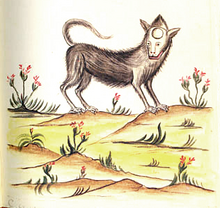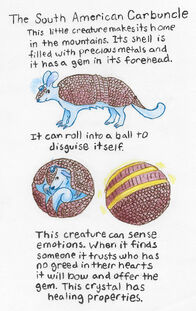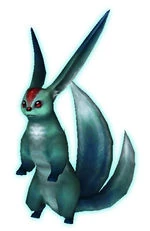Carbuncles are small, nocturnal herbivores sighted on the southern tip of South America. They are heavily associated with gemstones and precious metals, and have luminous gems embedded in their foreheads. Descriptions of the animals themselves vary - historically they were described with rodent features and often had shells, but in modern times they're generally presented as feline or canine.
Appearance[]
While descriptions of these creatures vary wildly, most sources agree that they are small animals with a mirror or gem set in their foreheads. These gems are generally described as red and glow like fire in the dark,[1][2] but carbuncles have a lid, hood, or curtain they can use to cover their gems when necessary. They are usually quadrupeds,[3] but have occasionally been observed with more legs.
One of the most prominent legends claims they are a little larger than mice, shaped like an ear of corn, with two-part shells. A bluish-white light that can be seen from a league away shines from within the shell, but they can close up and conceal themselves to look like an ordinary rock.[4]
Another source describes one specimen as looking a lot like a weasel, with smooth, dark brown fur. It had a long head, large eyes, and a short tail that was a little less bushy than a squirrel's. Its gem was hidden by a hood of skin that had to be pulled back to see it.[5]

A carbuncle from Trujilla de Perú. Note the crest or "curtain", which would fold down to hide the gem.
In yet another account the curtains they use to cover their gems have "beautiful plumage", implying that the animals are feathered. This description also mentions beautiful spots on their breasts.[6]
There are many more conflicting descriptions of carbuncles, and they have been compared to cats, dogs, mice, turtles, foxes, molluscs, otters,[7] and more.[8] In modern times, a carbuncle can be depicted as just about any kind of animal so long as it has the signature red, glowing gem in its forehead.
One more description, however, eschews the forehead gem entirely - instead, the carbuncle is a cat-sized quadruped with a luminous beard whose colors shift constantly. It's considered a guardian of precious metals and treasure.[9]
Gonzalo Fernandez de Oviedo draws a connection between the carbuncle's gem and a legend about crystals found in the brains of dragons[2], called dracontites. However, these crystals are a translucent white.[10]
Behavior[]

Illustration by PhylVance
Carbuncles are nocturnal, herbivorous[3] animals that make their homes in the mountains of Paraguay, Argentina, and Chile. At night they come out of hiding to search for food and water,[4] and they can be observed because of the bright glow from their gems. They normally appear as bright lights that change locations each night,[5] but are easily distinguishable from bonfires made by humans. They are often, but not always, sighted in groups of two or more.[2]
They are difficult or even impossible to capture due to a variety of factors. Their fine hearing allows them to sense most dangers,[4] and their small size, agility, and jumping prowess makes them quick to escape. When injured or threatened, they produce a bright flash from the gemstones in their foreheads,[11][12] then obscure their gems entirely with the lid or curtain on their head. Any pursuers are blinded, then left in total darkness while the carbuncle flees.[1][13]
Despite their elusiveness, they were often hunted for their gems, which were said to bring great joy and fortune. However, the carbuncle could not be killed before retrieving the gem, or else it would lose all its splendor.[12] This detail seems to be a conflation with the legend of dragontites, which must also be removed from a creature while still alive.[2]
Anthropological information[]
The creature's name is most often some variation of "carbuncle", which is derived from an archaic word for red garnets. The word itself is derived from the Latin carbunculus, which means "little coal". However, Martin del Barco Centenera notes that they are called añang-pitá in Guarani,[12] and a missionary wrote that they are called inuyucuoy in "Pira" (perhaps Piratapuyo).[6] This implies that the creature, or at least a similar one, existed in local folklore prior to the arrival of Spanish conquistadors.
A similar creature by the same name was described as living in the mountains of the Philippines, depicted as a large, venomous snake with a glowing gem in its forehead. Its light was so bright that it made the night look like a clear day, and it was accompanied by smaller, ordinary snakes attracted by its brilliance. It also shares the lore that its gem can only be removed while the animal is alive, otherwise it loses its splendor.[14] Because the Philippines are so far from the carbuncle's usual range, and because the author of these observations is Spanish and could easily have heard of carbuncles before arriving there, it may be an example of carbuncles being superimposed onto local folklore rather than evidence that carbuncles were ever serpents.
In pop culture[]

A carbuncle as depicted in the Final Fantasy series.
- The Final Fantasy series features carbuncles as recurring summons. They are usually depicted as green fox- or squirrel-like creatures.
- The mobile game Puzzle & Dragons features a few kinds of carbuncles with different colored gemstones.
- Yu-Gi-Oh! has a card titled Crystal Beast Ruby Carbuncle which depicts a cat-like creature.
- The Pokémon Espeon and Carbink may draw inspiration from carbuncles.
- Carbuncles appear as creatures in several editions of the tabletop game Dungeons & Dragons. They also appear as monsters in Pathfinder.
- In Puyo Puyo , as well as Madou Monogatari, Carbuncle is a yellow rabbit that is the mascot of both series and a prominent character throughout the story.
Similar creatures[]
References[]
- ↑ 1.0 1.1 Valladares, Juan. Cavallero venturoso, vol I, B. Rodríguez Serra (1902). Pg 201.
- ↑ 2.0 2.1 2.2 2.3 Oviedo, Gonzalo Fernández de. Historia General y Natural de las Indias, vol II, Imprenta de la Real Academia de la Historia (1852). Pg 47-48.
- ↑ 3.0 3.1 Mendiburu, Manuel de. Diccionario histórico-biográfico del Perú, vol II, Lima, Imprenta de J. Francisco Solis (1896). Pg 404.
- ↑ 4.0 4.1 4.2 Vicuña Cifuentes, Julio. Mitos y Supersticiones Recogidos de la tradición oral chilena, Santiago de Chile, Impr. Universitaria (1915). Pg 324-326.
- ↑ 5.0 5.1 Boletín, issue 5, Instituto Bibliográfico Mexicano (1905). Pg 724-725.
- ↑ 6.0 6.1 Southey, Robert. Omniana, or Horae Otiosiores, vol II, London: Longman, Hurst, Rees, Orme, and Brown (1812). Pg 269-272.
- ↑ Savariego, Juan Ximénez. Tratado de peste, Claudio Bolan (1602). Pg clxxx.
- ↑ Arellano, Ignacio. Un pasaje oscuro de Góngora aclarado: el animal tenebroso de la Soledad primera, Criticón (2014).
- ↑ Álvarez, Renato Cárdenas. El Libro de la Mitología de Chiloé, ATELÍ y Cía. Ltda. (1997).
- ↑ Isidore. Etymologies, Cambridge University Press (2006). Pg 326.
- ↑ Lozano, Pedro. Historia de la conquista del Paraguay, Río de la Plata y Tucumán, vol I, Casa editora "Imprenta popular" (1878). Pg 299.
- ↑ 12.0 12.1 12.2 Centenera, Martín del Barco. La Argentina (1602). Pg 31.
- ↑ Techo, Nicolás del. Historia de la Provincia del Paraguay, vol II, Madrid, A. de Uribe (1897). Pg 393-394.
- ↑ Delgado, Juan José. Historia general sacro-profana, política y natural de las islas del poniente llamadas Filipinas, J. Atayde (1892). Pg 90.